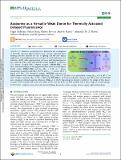Files in this item
Azaborine as a versatile weak donor for thermally activated delayed fluorescence
Item metadata
| dc.contributor.author | Sudhakar, Pagidi | |
| dc.contributor.author | Kuila, Suman | |
| dc.contributor.author | Stavrou, Kleitos | |
| dc.contributor.author | Danos, Andrew | |
| dc.contributor.author | Slawin, Alexandra Martha Zoya | |
| dc.contributor.author | Monkman, Andrew | |
| dc.contributor.author | Zysman-Colman, Eli | |
| dc.date.accessioned | 2023-05-19T09:30:15Z | |
| dc.date.available | 2023-05-19T09:30:15Z | |
| dc.date.issued | 2023-05-31 | |
| dc.identifier | 285330661 | |
| dc.identifier | c65b71bd-838e-4551-a231-6ebb9659f92d | |
| dc.identifier | 85160846881 | |
| dc.identifier.citation | Sudhakar , P , Kuila , S , Stavrou , K , Danos , A , Slawin , A M Z , Monkman , A & Zysman-Colman , E 2023 , ' Azaborine as a versatile weak donor for thermally activated delayed fluorescence ' , ACS Applied Materials & Interfaces , vol. 15 , no. 21 , pp. 25806-25818 . https://doi.org/10.1021/acsami.3c05409 | en |
| dc.identifier.issn | 1944-8244 | |
| dc.identifier.other | ORCID: /0000-0002-9527-6418/work/135454833 | |
| dc.identifier.other | ORCID: /0000-0001-7183-6022/work/135455109 | |
| dc.identifier.uri | https://hdl.handle.net/10023/27648 | |
| dc.description | Funding: H2020 Marie Sklodowska-Curie Actions - 891606, 812872; Engineering and Physical Sciences Research Council - EP/T02240X/1. | en |
| dc.description.abstract | Extensive research has been devoted to the development of thermally activated delayed fluorescence emitters, especially those showing pure-blue emission for use in lighting and full-color display applications. Toward that goal, herein we report a novel weak donor, 1,4-azaborine (AZB), with complementary electronic and structural properties compared to the widely used dimethylacridan (DMAC) or carbazole (Cz) donors. Coupled with a triazine acceptor, AZB-Ph-TRZ is the direct structural analogue of the high-performance and well-studied green TADF emitter DMAC-TRZ and has ΔEST = 0.39 eV, a photoluminescence quantum yield (ΦPL) of 27%, and λPL = 415 nm in 10 wt % doped mCP films. The shortened analogue AZB-TRZ possesses red-shifted emission with a reduced singlet–triplet gap (ΔEST = 0.01 eV) and fast reverse intersystem crossing (kRISC of 5 × 106 s–1) in mCP. Despite a moderate ΦPL of 34%, OLEDs with AZB-TRZ in mCP showed sky-blue emission with CIE1931(x,y) of (0.22,0.39) and a maximum external quantum efficiency (EQEmax) of 10.5%. Expanding the chemist’s toolkit for the design of blue donor–acceptor TADF materials will enable yet further advances in the future, as AZB is paired with a wider range of acceptor groups. | |
| dc.format.extent | 13 | |
| dc.format.extent | 5185875 | |
| dc.language.iso | eng | |
| dc.relation.ispartof | ACS Applied Materials & Interfaces | en |
| dc.subject | Azaborine donor | en |
| dc.subject | Thermally activated delayed fluorescence | en |
| dc.subject | Donor-acceptor | en |
| dc.subject | Triazine | en |
| dc.subject | Organic light-emitting diodes | en |
| dc.subject | DAS | en |
| dc.subject | MCC | en |
| dc.title | Azaborine as a versatile weak donor for thermally activated delayed fluorescence | en |
| dc.type | Journal article | en |
| dc.contributor.sponsor | European Commission | en |
| dc.contributor.institution | University of St Andrews. School of Chemistry | en |
| dc.contributor.institution | University of St Andrews. Centre for Energy Ethics | en |
| dc.contributor.institution | University of St Andrews. EaSTCHEM | en |
| dc.identifier.doi | 10.1021/acsami.3c05409 | |
| dc.description.status | Peer reviewed | en |
| dc.identifier.grantnumber | 812872 | en |
This item appears in the following Collection(s)
Items in the St Andrews Research Repository are protected by copyright, with all rights reserved, unless otherwise indicated.

